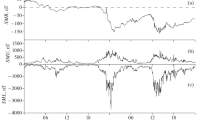Abstract
In the ARAKS experiment, electron pulses were injected into the ionosphere from onboard a rocket. For different series of pulses, the initial energy of electrons was 27 and 15 keV and the current strength was ∼0.5 A. On board the rocket, the distributions of electron fluxes directed toward the rocket were measured using the retarding potential by the electron energy up to 3000 eV. In this work, it is shown that the appearance of extreme values of the intensity of electron fluxes higher than 200 eV at the tail of the electron energy distribution can be explained by the nonmonotonic acceleration of electrons in the fields of electrostatic turbulence. The dynamics of electron and ion fluxes can be influenced by the polarization drift. It should be noted that extreme values of the flux intensities were not observed at heights lower than 130 km. This can be connected with the suppression of electrostatic oscillations by collisions of electrons with ionospheric components.
Similar content being viewed by others

References
Cambou, F., Dokukine, V.S., Lavergnat, J., Pellat, R., Reme, H., Saint-Marc, A., Sagdeev, R.Z., and Zhulin, I.A., General Description of the ARAKS Experiments, Ann. Geophys., 1980, vol. 36, no. 3, pp. 271–283.
Dechambre, M., Gusev, G.A., Kushnerevsky, Yu.V., Lavergnat, J., Pellat, R., Pulinets, S.A., Selegey, V.V., and Zhulin, I.A., High Frequency Waves during the ARAKS Experiments, Ann. Geophys., 1980a, vol. 36, no. 3, pp. 333–339.
Dechambre, M., Kushnerevsky, Yu.V., Lavergnat, J., Pellat, R., Pulinets, S.A., and Selegey, V.V., Waves Observed by the ARAKS Experiments: The Whistler Mode, Ann. Geophys., 1980b, vol. 36, no. 3, pp. 341–349.
Dechambre, M., Lavergnat, J., and Pellat, R., Waves Observed by the ARAKS Experiments: The VLF Range, Ann. Geophys., 1980c, vol. 36, no. 3, pp. 351–356.
Gringauz, K.I. and Shutte, N.M., The Study of Electron Fluxes with Energy <3 keV in the ARAKS Experiment of January 26, 1975, Ann. Geophys., 1980, vol. 36, no. 3, pp. 381–388.
Gringauz, K.I., Musatov, L.S., Shutte, N.M., Beliashin, A.P., Denstchikova, L.I., and Kopilov, V.A., A Device for Determination of the Electrical Potential îf a Rocket Carrying an Electron Gun, Space Sci. Instrum., 1978, vol. 4, no. 2–3, pp. 205–212.
Hess, W.N., Trichel, M.C., Davis, T.N., Beggs, W.C., Kraff, G.E., Stassinopoulos, E., and Naier, E.J.R., Artificial Aurora Experiment: Experiment and Principal Results, J. Geophys. Res., 1971, vol. 76, no. 25, pp. 6067–6092.
Izhovkina, N.I., Karpachev, A.T., Prutenskii, I.S., Pulinets, S.A., Klos, Z., and Rothkaehl, H., Heating and Decay of Irregularities in the Electrostatically Unstable Plasma of the Upper Ionosphere, Geomagn. Aeron., 2001, vol. 41, no. 4, pp. 491–494 [Geomagn. Aeron. (Engl. transl.), 2001, vol. 41, pp. 469–473].
Lavergnat, J., Dechambre, M., Pellat, R., Kushnerevsky, Yu.V., and Pulinets, S.A., Waves Observed by the ARAKS Experiments: Generalities, Ann. Geophys., 1980a, vol. 36, no. 3, pp. 323–332.
Lavergnat, J., Le Queau, D., Pellat, R., and Roux, A., Nonlinear Mechanism for the Production of the Low Frequency Electrostatic Waves, Ann. Geophys., 1980b, vol. 36, no. 3, pp. 439–442.
Le Queau, D., Pellat, R., and Saint-Marc, A., An Investigation of the Electrostatic Linear Instabilities of a Radially Limited Electron Beam, Ann. Geophys., 1980, vol. 36, no. 3, pp. 433–437.
Morozov, A.I., Chusov, I.V., Pokrovsky, I.B., Ryabchikova, L.V., Petrov, E.M., Dokukine, V.S., and Ruzhin, Yu.Ya., Caesium Plasma Source for the ARAKS Experiment, Space Sci. Instrum., 1978, vol. 4, no. 2–3, pp. 251–252.
Paton, B.E., Dudko, V.N., Bernadsky, V.N., et al., A Powerful Electron Accelerator for Active Space Experiments, Space Sci. Instrum., 1978, vol. 4, no. 2–3, pp. 131–138.
Winckler, J.R., An Investigation of Wave Particles Interactions and Particle Dynamics Using Electron Beams Injected from Sounding Rockets, Space Sci. Rev., 1974, vol. 15, pp. 751–780.
Author information
Authors and Affiliations
Corresponding author
Additional information
Original Russian Text © N.I. Izhovkina, 2012, published in Geomagnetizm i Aeronomiya, 2012, Vol. 52, No. 3, pp. 401–405.
Rights and permissions
About this article
Cite this article
Izhovkina, N.I. Dynamics of electron fluxes in the near-rocket region in the ARAKS experiment. Geomagn. Aeron. 52, 378–382 (2012). https://doi.org/10.1134/S0016793212030061
Received:
Accepted:
Published:
Issue Date:
DOI: https://doi.org/10.1134/S0016793212030061



